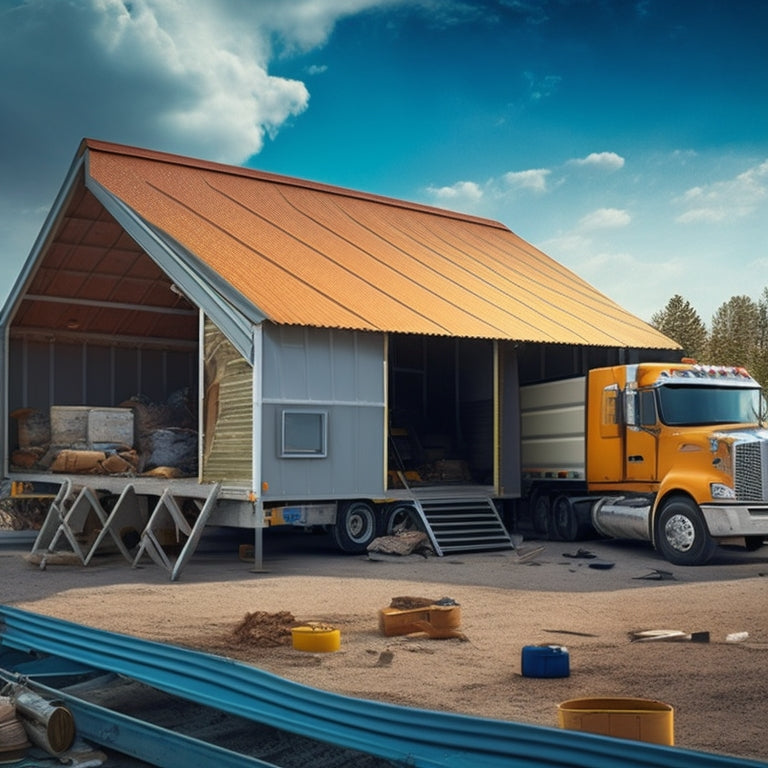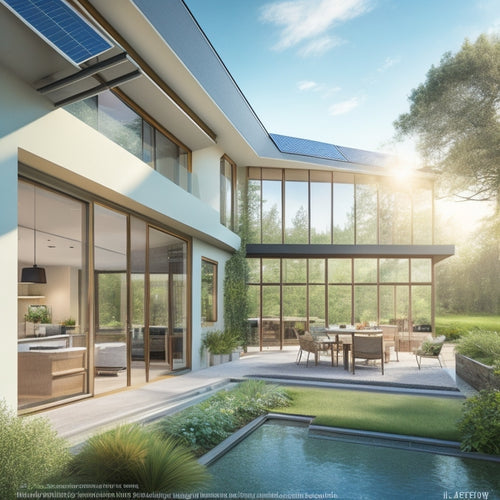
10 Essential Tips for Affordable Semi-Trailer Roof Solutions
Share
To find the right affordable semi-trailer roof solution, start by evaluating your energy needs with an audit to understand your power consumption patterns. Choose high-efficiency solar panels that fit your roof type, and assess your roof's solar potential by considering orientation, shading, and obstacles. Select a compatible mounting system that can withstand environmental conditions, and make sure your design complies with local building codes. Next, maximize your energy output and savings, and prioritize a safe and secure installation. You're on the right track to minimizing energy expenses and environmental impact – and there's more to explore to get the most out of your investment.
Key Takeaways
• Conduct an energy audit to determine your semi-trailer's energy needs and identify areas for improvement.
• Choose high-efficiency solar panels that meet industry standards and comply with safety regulations.
• Assess your roof's solar potential by evaluating orientation, shading, and obstacles affecting sunlight.
• Select a compatible mounting system that can withstand environmental conditions and integrates with your roof material.
• Ensure your roof design complies with local building codes, including structural integrity and accessibility standards.
Assessing Your Semi-Trailer's Energy Needs
As you prepare to upgrade your semi-trailer's roof, you need to determine how much energy your trailer actually consumes. This is vital in ensuring you install the right amount of solar panels to meet your energy needs.
Conducting an energy audit will help you understand your trailer's power consumption patterns. This involves monitoring your energy usage over a period, typically a week or a month, to identify areas of high energy consumption.
During the audit, pay attention to the type and number of appliances, lighting, and HVAC systems you use. Take note of the wattage and voltage requirements for each device. This information will help you calculate your trailer's total power consumption. You can use an energy monitoring device or consult with an energy expert to help you with the audit.
Once you have a clear picture of your energy needs, you can determine the size of the solar panel system required to meet your power demands. This will ensure you install a system that can efficiently power your trailer, reducing your reliance on traditional fuel sources and minimizing your carbon footprint.
Choosing the Right Solar Panel Type
With your energy needs assessed, you're ready to choose the right solar panel type to meet those needs, and there are several options available for evaluation.
When selecting a solar panel, consider the following key factors to make sure you get the most efficient and durable option for your semi-trailer roof:
-
Efficiency Ratings: Look for panels with high efficiency ratings (measured in percentage) to maximize energy production.
-
Panel Durability: Evaluate the panel's durability by checking the manufacturer's warranty, material quality, and weather resistance.
-
Certifications and Compliance: Confirm the panels meet industry standards and comply with safety regulations.
Measuring Your Roof's Solar Potential
When measuring your semi-trailer roof's solar potential, you'll need to take into account two important factors: roof orientation and shading.
You'll want to determine whether your roof is ideally angled to maximize energy harvesting, and also assess any potential obstructions that might cast shade on your solar panels.
Roof Orientation Matters
Your semi-trailer's roof orientation plays a crucial role in its ability to harness solar energy, and understanding its solar potential is vital for maximizing energy harvest.
When it comes to measuring your roof's solar potential, roof orientation is key. The way your roof is angled and positioned can greatly impact the amount of solar energy it can generate.
Here are three key factors to take into account when evaluating your roof's solar potential:
-
Roof architecture: The design and structure of your roof can influence the amount of sunlight it receives. For example, a roof with multiple angular surfaces can create shade, diminishing its solar potential.
-
Angular surfaces: The angle at which your roof is positioned can affect the amount of direct sunlight it receives. A south-facing roof, for instance, receives more direct sunlight than a north-facing roof.
-
Obstacles and shading: Any obstacles or shading on your roof can lower its solar potential. Make sure that your roof is free of obstacles and shading to maximize energy harvest.
Assessing Shading Factors
Now that you've considered the impact of roof orientation on solar potential, it's time to evaluate the shading factors that can further affect energy harvest on your semi-trailer's roof.
A thorough Shade Analysis is essential to identify areas that may hinder your solar panel's performance. You'll want to inspect your roof for any obstructions, such as trees, buildings, or other structures that could cast a shadow on your solar panels.
Tree Interference, in particular, can be a significant issue. If there are trees nearby, their branches or leaves may block sunlight from reaching your solar panels, reducing their efficiency. Take note of the tree species, their height, and proximity to your semi-trailer. Consider trimming or removing trees that pose a significant shading risk.
When conducting your Shade Analysis, also consider the time of day and year. Shading patterns can change throughout the day and season, affecting your solar panel's energy output.
Selecting a Compatible Mounting System
You'll need a mounting system that's specifically designed for your semi-trailer roof's unique characteristics and the type of roof solution you've chosen. A compatible mounting system ensures a secure and reliable installation, which is essential for safety and performance.
When selecting a mounting system, consider the following key factors:
-
Structural integrity: The mounting system must be able to withstand various environmental conditions, such as wind, rain, and snow.
-
Roof type compatibility: Guarantee the mounting system is designed for your semi-trailer roof's material, whether it's metal, fiberglass, or another material.
-
System integration: The mounting system should seamlessly integrate with your chosen roof solution, such as solar panels or skylights, to ensure top-notch performance.
Understanding Local Building Codes
When planning your semi-trailer roof solution, it's crucial to understand the local building codes that apply to your project.
You'll need to make sure your design meets code compliance requirements, which can vary greatly depending on your location.
Code Compliance Requirements
When designing a semi-trailer roof, it's important to take into account local building codes, which vary by region and can impact your project's feasibility. It's vital to confirm that your roof design complies with the regulatory framework in your area to avoid costly rework or even project cancellation.
Here are three essential considerations to keep in mind:
-
Structural integrity: Your roof design must meet local building codes for structural integrity, including wind load, snow load, and seismic requirements.
-
Fire safety: You must adhere to local fire safety regulations, including flame spread ratings and fire-resistance ratings for roofing materials.
-
Accessibility: Make sure that your roof design meets local accessibility standards, including wheelchair ramps and emergency exit requirements.
Zoning Ordinance Restrictions
Zoning ordinances, which dictate how property can be used, also impact semi-trailer roof design by imposing restrictions on height, size, and placement. These restrictions can greatly affect your semi-trailer roof solution, so it's important you understand the local zoning ordinances before designing your roof.
You'll need to research the specific zoning laws in your area to make sure your semi-trailer roof complies with the regulations. For instance, some areas may have height restrictions to maintain a certain aesthetic or to prevent obstruction of views. Others may have size restrictions to prevent overcrowding or to maintain a certain level of safety.
It's essential to explore potential zoning loopholes that can help you navigate these restrictions. Urban planning experts can provide valuable insights into finding creative solutions that meet the zoning requirements while still achieving your design goals.
Don't assume that you can't find a way to meet the zoning ordinances; instead, work with experts to find a solution that works for you. By doing so, you can ensure your semi-trailer roof solution is both affordable and compliant with local regulations.
Sourcing Affordable Solar Panels Online
You can find affordable solar panels online by comparing prices from reputable retailers and wholesalers, which often offer discounts and promotions to customers who buy in bulk or during seasonal sales. This is especially true in the wholesale market, where you can find online deals that can greatly reduce the cost of your solar panel system.
Here are some tips to keep in mind when sourcing affordable solar panels online:
-
Research and compare prices: Look for online retailers that offer competitive pricing and discounts for bulk orders.
-
Check for certifications and warranties: Make sure that the solar panels you choose meet safety and quality standards, and are backed by reliable warranties.
-
Read reviews and ask for referrals: Check online reviews and ask for referrals from friends, family, or colleagues who've installed solar panels to get an idea of the best options.
Maximizing Energy Output and Savings
Maximizing your solar panel system's performance is essential to maximizing energy output and savings, and it starts with ensuring that your solar panels are angled correctly to capture the most sunlight. By doing so, you'll be able to generate more power and reduce your reliance on traditional energy sources.
Conducting an energy audit is also vital in identifying areas of energy inefficiency in your semi-trailer. This will help you pinpoint opportunities to optimize your energy usage and reduce waste.
A thorough cost analysis will also help you determine the most cost-effective solutions for your solar panel system. By understanding the costs associated with your energy usage, you can make informed decisions about your energy investments. Remember, every dollar saved on energy costs is a dollar that can be reinvested in your business.
Ensuring a Safe and Secure Installation
When it comes to ensuring a safe and secure installation, you'll want to start by conducting a thorough roof inspection. This involves checking for signs of wear and tear, damage, or corrosion that could compromise the structural integrity of your semi-trailer's roof.
Roof Inspection Checklist
Regularly inspecting your semi-trailer roof guarantees a safe and secure installation by catching potential issues before they become major problems.
As you inspect your roof, consider the following factors that can affect its condition:
-
Roof Age Factors: Older roofs are more prone to damage and wear, so pay special attention to roofs nearing the end of their lifespan.
-
Weathering Patterns: Inspect your roof for signs of weathering, such as cracks, fading, or corrosion, which can compromise its structural integrity.
-
Previous Repairs: Check for any previous repairs or patchwork, which may not be up to code or may be hiding underlying issues.
Structural Integrity Checks
You'll want to perform structural integrity checks to make sure your semi-trailer roof can withstand harsh weather conditions and heavy cargo loads. This is essential to guarantee a safe and secure installation that won't put you or others at risk.
Regular inspections are key to identifying potential weaknesses or damage that could lead to catastrophic failures. During these checks, you'll need to assess the roof's overall condition, looking for signs of wear, corrosion, or damage.
You should also perform load calculations to determine the maximum weight capacity of your semi-trailer roof, taking into account factors like cargo density and distribution. This will help you avoid overloading, which can cause structural failure.
Additionally, inspect the roof's support structures, such as beams and brackets, to ensure they're securely attached and can withstand the stresses of hauling heavy cargo.
Monitoring and Maintaining Your System
To guarantee peak performance and extend the lifespan of your semi-trailer roof system, consistent inspections and routine maintenance are essential. You can't afford to wait until something goes wrong, as this can lead to costly repairs, downtime, and even safety risks. By staying on top of your system's condition, you can identify and address potential issues before they become major problems.
Regular system checks are pivotal to make sure your semi-trailer roof is functioning as it should. Here are three key aspects to focus on:
-
Seal integrity: Inspect the seals around vents, doors, and other openings to make sure they're tight and free of damage.
-
Fastener security: Check that all screws, bolts, and rivets are securely in place and not loose or damaged.
-
Surface condition: Look for signs of wear, rust, or corrosion on the roof's surface, and address any issues promptly.
Evaluating ROI and Long-Term Benefits
Calculate the return on investment (ROI) of your semi-trailer roof system to understand its long-term value and make informed decisions about maintenance, upgrades, and replacements. This critical step helps you evaluate the financial benefits of your investment and prioritize your spending.
By conducting a thorough cost analysis, you'll be able to identify areas where you can cut costs without compromising safety or performance.
As you assess your ROI, consider both short-term and long-term financial projections. Will your new roof system reduce maintenance costs or minimize downtime? Will it increase your fleet's overall efficiency and profitability?
By answering these questions, you'll gain a clear understanding of your investment's value and make data-driven decisions about future upgrades or replacements.
Frequently Asked Questions
Can I Install Solar Panels on a Curved Semi-Trailer Roof?
You can install solar panels on a curved semi-trailer roof, but you'll need to verify that the curved surface is reinforced to support the added weight, and consider customized mounting systems for a secure fit.
How Do I Handle Snow Accumulation on My Solar Panels?
You'll need to prioritize snow removal to maintain panel efficiency; gently sweep or brush off snow, avoiding harsh chemicals or abrasive materials, and consider investing in snow-load-rated panels or automatic snow removal systems.
Do Solar Panels Void My Semi-Trailer's Warranty?
You should check your semi-trailer's warranty specifics to make sure solar panels won't void it; however, with manufacturer approval, you're likely in the clear, so don't hesitate to reach out to them for confirmation.
Can I Install Solar Panels Myself or Do I Need a Pro?
'As you ponder installing solar panels, imagine the weight of a faulty job on your semi-trailer's roof; DIY risks outweigh benefits, whereas hiring a pro guarantees a safe, efficient, and warranty-protected installation, giving you peace of mind on the open road.'
Will Solar Panels Affect My Semi-Trailer's Aerodynamics?
You're right to wonder if solar panels will affect your semi-trailer's aerodynamics. To put your mind at ease, consider aerodynamic testing or wind tunnel analysis to verify that the panels won't compromise your trailer's airflow or stability.
Related Posts
-

5 Efficient Air Circulation Methods for Green Homes
You can utilize the power of natural ventilation techniques, whole house fans, and solar-powered ventilation systems ...
-

What Water-Saving Gardens Complement Electric Vehicle Ownership?
As you pair your electric vehicle with a water-saving garden, you're not only reducing your carbon footprint but also...
-

What Air Purifiers Save Energy in Work Areas?
You can cut energy costs and reduce your carbon footprint by choosing air purifiers designed with energy efficiency i...


